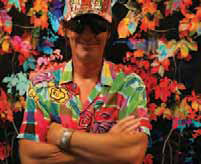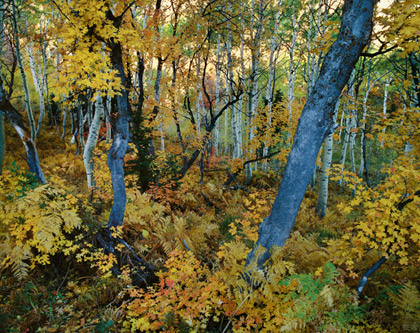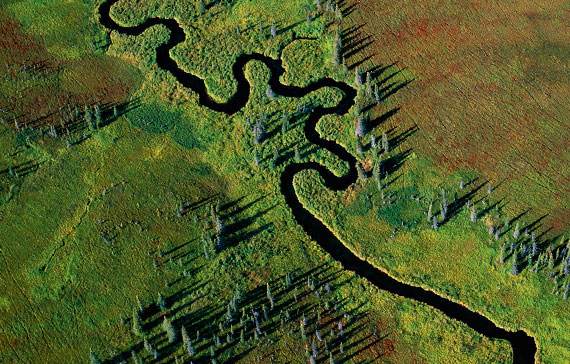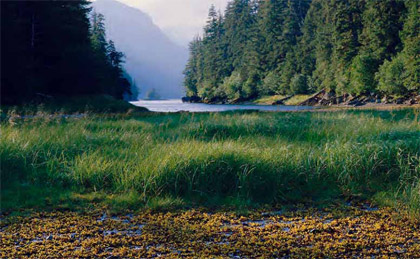Robert Glenn Ketchum, Nature’s Tireless Advocate: A Conviction of the Heart
Robert Glenn Ketchum is a world-renowned photographer, conservationist and author. For 40 years his imagery and books have helped to define contemporary color photography. At the same time both he and his work have passionately and successfully addressed critical environmental issues. Dedication to the natural world, particularly within North America, has earned him numerous awards and critical acclaim including: American Photo magazine’s “100 most important people in photography,” Audubon’s 100 people who “shaped the environmental movement in the 20th Century” and the United Nation’s Outstanding Environmental Achievement Award. Ketchum has been in the company of kings and queens, princes and princesses, admirals and generals, and even a few presidents. Historians will remember Ketchum as a great artist but, more importantly, as a truly great human being who never wavered from a struggle or faltered in his convictions.
A Fortuitous Beginning

© Photograph: Cynthia J. Woolley
Ketchum’s life and career play out like a movie with a fortuitous beginning, a momentous middle and an evolving out come. Like a set of building blocks, one securely placed upon the other, events have created a self-fulfilling prophecy that has brought him closer to his clearly defined destiny. Ketchum believes the beginning of this journey originated with a “convergence of ideas that were filtering around in public consciousness and education at that particular moment in time.” A product of an all boys’ boarding and prep school with a “very rigorous high-school academic background,” this disciplined and logical thinker entered the University of California at Los Angeles (UCLA) in 1966. This was the same time Eliot Porter, Rachel Carson and Silent Spring, and Aldo Leopold came to the forefront of American education, and American consciousness was blossoming, arguably, like never before.A true poster child for why the Arts should be part of every curriculum, Ketchum was exposed to this new world for the first time because of UCLA’s mandatory “breadth requirements in the Arts.”
“I took some studio classes, and one of those introduced me to the camera. We got along from the very minute that I picked it up; I just liked it. There’s a certain magic to it; there always has been, even about taking the picture. And so it captured me; it captured my imagination,” remembers Ketchum. He and his camera became best friends, traveling everywhere together, their identities evolving congruously within UCLA’s gigantic campus. “As circumstance would have it, I had the opportunity to hook-up with and end up in the entourage of some of the era’s preeminent rock bands like the Doors, Cream and Hendrix. And so through college I picked up date change, movie money, gas money and things like that by taking 8×10 black and white glossies of casual moments with various bands on stage, behind stage, in cars and in studios. It was pretty junk photography because I was a pretty bad photographer; but it kept me engaged in photography, and it got me in and out of scenes. It gave me an identity,” explains the artist.

© Robert Glenn Ketchum
Silently and imperceptibly, Carson, Leopold and emerging organizations like the Sierra Club were helping to mold Ketchum’s ideas and perceptions. One day while camping in Big Sur on his way back from the Monterey Pop Festival, Ketchum wandered alone up a narrow Redwood canyon with a beautiful stream. “I had this magnificent moment in the forest where I took my first landscape pictures, and I tied a whole bunch of things together . . . things Carson said in her book and things Leopold said about our personal ethic with regard to the land. Everything was ringing around in my head, manifesting themselves in this epiphanal moment in the Redwoods. . . . I decided maybe there was some way, within the work, to speak out on behalf of the land or to make the work serve it. I had this view of myself as a photographer and all these things that needed to be done on behalf of the environment and ideas that the public needed to be connected with, and I could clearly see how I could play into that. “And when I graduated in 1970 from UCLA, a lot of those heroes of rock ’n roll, whom I had admired and photographed, had killed themselves so I thought it was a good idea to get my self out of that environment and go somewhere else. I went to Central Idaho, where I had previously hunted and fished with my dad, and figured I would work as a professional photographer,” remember Ketchum. This decision was the beginning of the artist’s second life chapter, which was marked by outstanding events and high profile working relationships.
A Momentous Middle
“So I went there like most kids do after college. By having those other ideas banging around inside my head, I brought them together in an interesting way because I found myself with my healthier, more athletic local friends in Central Idaho, skiing in the back country, rock climbing in the summer, backpacking, starting to do things that were taking me out into wild country and introducing me to a whole other pattern of behavior. I found myself taking commercial landscape photography that was going into places like Sierra Club wall calendars and Wilderness Book calendars. Through most of the ’70s, I was making photographs and working out ideas in my head,” Ketchum continues.

© Robert Glenn Ketchum
By the end of the ’70s, as a result of his successful and widely recognized involvement within the academic community, Ketchum ascended to Curator of Photography at the National Park Foundation, for whom he put together an exhibit called “American Photographers in the National Parks.” Ketchum recalls: “It was also a big Viking book, and it was a huge show in big museums all over the U.S. – a huge exhibition surveying photography from the 1850s to the present. It was very well received. It explored the way photographers and parks had been interactive with each other in the beginning: the photography helping to create parks and, later, parks helping to create photographers. It confirmed for me that photographers had been successful using their work in the political system for a long time in a very significant way. I was especially moved by Eliot Porter’s book, Glen Canyon: The Place No One Knew, which was the first time I had seen such an incredible body of color photography linked to an advocate text. Now, in that case it was a lament; and I made a personal pledge that I never wanted to be involved with a lament. I wanted to be out in front of things happening – to keep them from happening so there weren’t any more laments.”This event set a “tone” for Ketchum; but, more importantly, it empowered him as an individual photographer. He explains, “I wanted to take my work from the place where I was using Nature to pay my bills to the place where I was serving Nature in the belief that my bills would pay themselves.”
His new philosophy of “do the work well and with good intention, and everything else will serve you” was the beginning of a new way of thinking and working. This led him to the Lila Wallace Fund and the Hudson River. Ketchum recalls the project: “When I photographed the Hudson, I saw 400 years of American history and a metaphor for the way we treated a major American river in those 400 years of evolutionary thought. And I speculated, “If I can do it in pictures, it would be a really interesting reflection on what we had done to a river like that.’ So, I photographed everything – the good, the bad and the ugly and everything in between.” Ketchum never thought the Fund would use his less complimentary photos because he presumed they were looking for “nice, tidy art” for the planned Hudson River book; but they surprised him by saying they were “conservation based” and his photographs were exactly what they were looking for.

© Robert Glenn Ketchum
According to Ketchum, the Wallace Fund bought volumes of the book from the publisher and distributed them within the conservation community. He witnessed first hand how to execute a project with alternate funding sources, rather than through traditional commercial outlets, and recalls: “I got to witness how to turn publishing from coffee table to advocacy.” Instead of waiting for people to pick up books from library shelves, this process directed books to people by giving them away. According to Ketchum, “In the case of the Wallace Fund, they did it from largesse, but the idea was born, and I’ve learned how to progressively down scale it so environmental groups benefit with as minimal an expense as possible.”
Ketchum’s second, and probably best known, endeavor was his Tongass Rain Forest Project, which began in 1985. This opportunity, the result of another non profit foundation commission, sent him to Alaska to create pictures to enhance the dry legislation being proposed as the “Timber Reform Bill.” Ketchum remembers: “I read the 600+ pages of the Bill and thought ‘Oh, my Gosh! If this is what everyone has to read, no one will even read the Bill, let alone pass it.’ So I really was on a mission to get it, to understand what was going on, and to present it in as honest, direct and well researched a way as I could. I went to Alaska, contrary to the way the book may sound, with the idea that logging and tree farms were fair options. As it turns out, the biology and the sound science don’t read like that in the Tongass. The market is pretty poor for the timber being cut vs. the biology being saved. As a matter of fact, I look at the Tongass more like it’s corporate welfare and our tax money is being used to subsidize corporations that can’t make a clear profit on the timber. So, to me, it’s an inexcusable use of tax dollars. It’s a bad way to run the federal government and a very bad biological practice. That’s what I learned from two years on the ground in Alaska trying to do as much neutral research as possible. In the end, with the book, I came to my own conclusions.” And in the end, Ketchum’s work in the Tongass is credited with helping to pass the Tongass Timber Reform Bill of 1990. This significant legislation established five major wilderness areas and simultaneously protected more than 1 million acres of old growth trees in the world’s largest temperate rain forest.

© Robert Glenn Ketchum
Other memorable events followed upon the heels of the Tongass, including helping Congressman John Siberling, the National Park Service and the Akron Art Museum work on the Cuyahoga Valley area and giving the Valley a public image. Another was Sundance. “I did a residency with Robert Redford at Sundance. I was the first visual artist in residence at Sundance, and I did that on and off for three years. Having never met him, I was surprised when Redford called me directly, but he knew my work on the Tongass because it’s one of the issues that’s principal to the Natural Resources Defense Council (NRDC), and Redford is a spokesman for NRDC. And at that point, the Tongass campaign had been quite widely viewed. I had an audience with George Bush Sr. after the Tongass Timber Bill was signed. And then King Gustaf and the President of Brazil gave me the United Nations’ Outstanding Environmental Achievement Award in the Pulitzer Hall in Stockholm, Sweden. There was a lot of media and magazine coverage. I was visible and people saw that, so that’s probably where Redford picked that up,” concludes Ketchum.
An Evolving Outcome
With each progressive project, Ketchum becomes more adept at what he can accomplish not only in how to weave text into pictures to make a book work but also an exhibit, which are two entirely different things. He elaborates, “I’ve also become more adept at how to take the larger body of work and drive media with it as I’ve been doing for almost 12 years with Southwest Alaska and for some 25 years on the Tongass Rain Forest. You can see how it got started, why other people are attracted to it, how all of us are in there now and how it creates a much larger, unified, interrelated source of information. And, I think, this makes for a stronger, better informed public that you would hope would be more politically responsive.”
Like nature, Ketchum is becoming older, wiser and more independent in his meticulous choices. In the beginning and middle stages of his life, he was driven by external events and happenstance, but now he is in the driver’s seat. The 60-year old concurs: “That’s absolutely the truth. I think, in the beginning, I was carried along in good projects by great mentors and, as it should be, I tried to learn as much as I could as fast as possible. Ultimately, those mentors have died or dropped out of the fierceness of the battle or whatever. And, it was time for me to step-up and take that information and my ‘remix’ of things I learned and come out with my own version of it that would serve in some kind of way. I can see aspects of William Henry Jackson’s battle, handing out his book in Congress so people would understand Yellowstone, clearly reflected in my Tongass battle. And the same holds true with livebetter magazine on our Bristol Bay battle. This strategy has a long history, and we’re just sort of repeating it. But, we’re upgrading it with a better story and flashier pictures, hoping to make it a little clearer and a little more efficient, hoping users get more benefit out of it.”
Robert Glenn Ketchum is an enigma: aggressive and driven in his convictions yet tender and passionate in his words and wisdom. He is, at the same time, an artist, an entertainer, an educator, a mentor, an advocate and a friend. His approach is sophisticated but simple, enlightened yet respectful of all concerned . . . striving never to belittle or alienate, always hoping people will find their own way in their own time. Ketchum aims to lead people to an “informed decision.” “Anybody who’s in the media or who makes photographs is, to some degree, manipulating the perspective. The question is: ‘Are you doing it deftly and fairly, or are you doing it in an overreaching manner?’ I think ‘wildness’ is not only an extraordinary place but one that actually probably has all the answers. Not only do we not know them; we don’t even know all the questions yet. We need to pace ourselves more slowly and respectfully if we’re going to survive. I can see this clearly in relationships between factions that don’t necessarily agree over issues. The bottom line is we all have to get there together. Because to go forward, that’s all we have left,” concludes the incomparable Ketchum.
Ketchum is lecturing widely in conjunction with his Southwest Alaska traveling exhibition. He hopes to help prevent the most productive wild salmon fishery in the world’s history, Bristol Bay, from being destroyed by offshore oil and gas development and onshore mining. Please go to www.robertglennketchum.com for more information.




























